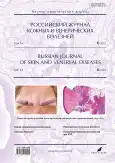Развитие саркоидоза кожи после проведения перманентного макияжа бровей
- Авторы: Снарская Е.С.1, Тавитова А.Р.1, Братковская А.В.1, Семко Н.С.1
-
Учреждения:
- Первый Московский государственный медицинский университет имени И.М. Сеченова (Сеченовский Университет)
- Выпуск: Том 24, № 6 (2021)
- Страницы: 581-588
- Раздел: ДЕРМАТОЛОГИЯ
- URL: https://journal-vniispk.ru/1560-9588/article/view/101665
- DOI: https://doi.org/10.17816/dv101665
- ID: 101665
Цитировать
Аннотация
В статье обобщены данные по историческим аспектам, эпидемиологии, этиопатогенезу, клинической картине, диагностике и лечению саркоидоза кожи. Саркоидоз ― хроническое мультисистемное заболевание из группы гранулематозов неизвестной этиологии, морфологической особенностью которого является развитие эпителиоидно-клеточных гранулём без казеозного некроза с процессами дистрофии, деструкции и фиброзирования в тканях различных органов. Диагностика и дифференциальная диагностика саркоидоза основаны на клиническом обследовании, изменении лабораторных данных, рентгенологических методах и биопсии кожи. В дифференциальный диагноз входят множество дерматозов, включая туберкулоидный тип лепры, туберкулёзную волчанку, красный плоский лишай, кольцевидную гранулёму и т.д. В лечении саркоидоза кожи используют кортикостероидные препараты, в том числе пролонгированного действия. В случае резистентности или наличия противопоказаний назначают синтетические противомалярийные и иммуносупрессивные средства.
По данным литературы, участились случаи развития гранулематозных реакций после проведения процедуры перманентного макияжа. Процедура татуажа широко распространена и считается безопасной, однако возможно развитие побочных реакций, в частности саркоидоза кожи.
Вопросы этиологии саркоидоза исследуются уже более 150 лет и до сих пор остаются малоизученными. В литературе всё чаще появляются сообщения о развитии реакций иммунного гранулематозного воспаления после проведения целого ряда косметических процедур, таких как татуаж, введение ботулотоксина А, инъекции гиалуроновой кислоты, проведение перманентного макияжа, биоревитализация, моделирование лица филлерами, блефаропластика. Увеличение числа случаев саркоидоза кожи вследствие косметологических манипуляций представляет большой научный интерес, а рост публикаций на эту тему свидетельствует о современных этиопатогенетических механизмах развития заболевания.
Приводим собственное клиническое наблюдение развития саркоидоза кожи без системных проявлений у 54-летней пациентки после процедуры перманентного макияжа бровей вне медицинской организации, без предварительного обследования и отсутствия последующего наблюдения (кожный процесс носит подострый характер; отмечается полиморфизм сыпи; высыпания на коже в области бровей представлены сливающимися папулами, очаги соответствуют области введения пигмента). По результатам физикального, лабораторного и инструментального исследования обнаружено множество эпителиоидно-клеточных гранулём без казеозного некроза. Пациентка получила курс внутриочагового обкалывания пролонгированным глюкокортикоидным препаратом (суспензия бетаметазона, № 5), что привело к полному регрессу высыпаний. Даны рекомендации к удалению пигмента. С целью профилактики инфицирования и минимизации рисков развития осложнений необходимым условием для проведения перманентного макияжа является высокий уровень квалификации дерматокосметолога, работающего в специализированном медицинском учреждении.
Полный текст
Открыть статью на сайте журналаОб авторах
Елена Сергеевна Снарская
Первый Московский государственный медицинский университет имени И.М. Сеченова (Сеченовский Университет)
Email: snarskaya-dok@mail.ru
ORCID iD: 0000-0002-7968-7663
SPIN-код: 3785-7859
Scopus Author ID: 8714450500
д.м.н., профессор
Россия, МоскваАлана Руслановна Тавитова
Первый Московский государственный медицинский университет имени И.М. Сеченова (Сеченовский Университет)
Email: alatavitova@mail.ru
ORCID iD: 0000-0003-1930-0073
аспирант
Россия, МоскваАнна Вадимовна Братковская
Первый Московский государственный медицинский университет имени И.М. Сеченова (Сеченовский Университет)
Автор, ответственный за переписку.
Email: annabratk24@gmail.com
ORCID iD: 0000-0002-7284-9113
клинический ординатор кафедры кожных и венерических болезней им. В.А. Рахманова Института клинической медицины
Россия, 119991, Москва, ул. Большая Пироговская, д. 4, с. 1Ника Сергеевна Семко
Первый Московский государственный медицинский университет имени И.М. Сеченова (Сеченовский Университет)
Email: n1kasemko21@yandex.ru
ORCID iD: 0000-0002-1556-7582
клинический ординатор кафедры кожных и венерических болезней им. В.А. Рахманова Института клинической медицины
Россия, МоскваСписок литературы
- Кряжева С.С., Снарская Е.С., Сурикова Н.С. Саркоидоз кожи. Москва: Шико, 2012. 80 с.
- Снарская Е.С., Теплюк Н.П. Фотогалерея морфотипов саркоидоза кожи // Российский журнал кожных и венерических болезней. 2021. Т. 24, № 2. С. 201–206. doi: 10.17816/dv65224
- Бородина. Г.Л. Некоторые аспекты истории изучения саркоидоза // Военная медицина. 2019. № 4. P. 65–71.
- Izikson L. Cutaneous sarcoidosis associated with cosmetic fillers // J Eur Acad Dermatol Venereol. 2009. Vol. 23, N 12. P. 1455–1456. doi: 10.1111/j.1468-3083.2009.03249.x
- Balighi K., Kamyab K., Azizpour A. Granuloma annulare after Botulonium toxin A injection: a rare association // J Cosmetic Dermatol. 2020. Vol. 19, N 10. P. 2549–2551. doi: 10.1111/jocd.13310
- Kwon S.H., Jeong K.M., Baek Y.S., Jeon J. Linear scar sarcoidosis on thin blepharoplasty line mimicking a hypertrophic scar: a case report // SAGE Open Medical Case Rep. 2018. Vol. 6. P. 2050313X1880399. doi: 10.1177/2050313x18803991
- Antonovich D.D., Callen J.P. Development of sarcoidosis in cosmetic tattoos // Arch Dermatol. Vol. 141, N 7. P. 869–872. doi: 10.1001/archderm.141.7.869
- Martín J.M., Revert A., Monteagudo C., et al. Granulomatous reactions to permanent cosmetic tattoos successfully treated with topical steroids and allopurinol // J Cosmetic Dermatol. 2007. Vol. 6, N 4. P. 229–231. doi: 10.1111/j.1473-2165.2007.00338.x
- Huisman S., van der Bent S.A., Wolkerstorfer A., et al. Granulomatous tattoo reactions in permanent makeup of the eyebrows // J Cosmetic Dermatol. 2019. Vol. 18, N 1. P. 212–214. doi: 10.1111/jocd.12540
- Tittelbach J., Peckruhn M., Schliemann S., Elsner P. Sarcoidal foreign body reaction as a severe side-effect to permanent makeup: successful treatment with intralesional triamcinolone // Acta Derm Venereol. 2018. Vol. 98, N 4. P. 458–459. doi: 10.2340/00015555-2876
- Дерматология для врачей общей практики. Учебник / под ред. проф. О.Ю. Олисовой. Москва: УМИ, 2019. 308 с.
- Tomita S., Mori K., Yamazaki H., Mori K. Complications of permanent makeup procedures for the eyebrow and eyeline // Medicine (Baltimore). 2021. Vol. 100, N 18. P. e25755. doi: 10.1097/MD.0000000000025755
- Bombonato C., Argenziano G., Lallas A., et al. Orange color: a dermoscopic clue for the diagnosis of granulomatous skin diseases // J Am Academy Dermatol. 2015. Vol. 72, N 1. P. S60–S63. doi: 10.1016/j.jaad.2014.07.059
- Lim A.Y., Tang P.Y., Oh C.C. Dermoscopy in cutaneous sarcoidosis // Dermatol Online J. 2021. Vol. 27, N 9. doi: 10.5070/D327955144
- Dai C., Shih S., Ansari A., et al. Biologic therapy in the treatment of cutaneous sarcoidosis: a literature review // Am J Clin Dermatol. Vol. 20, N 3. P. 409–422. doi: 10.1007/s40257-019-00428-8
Дополнительные файлы








